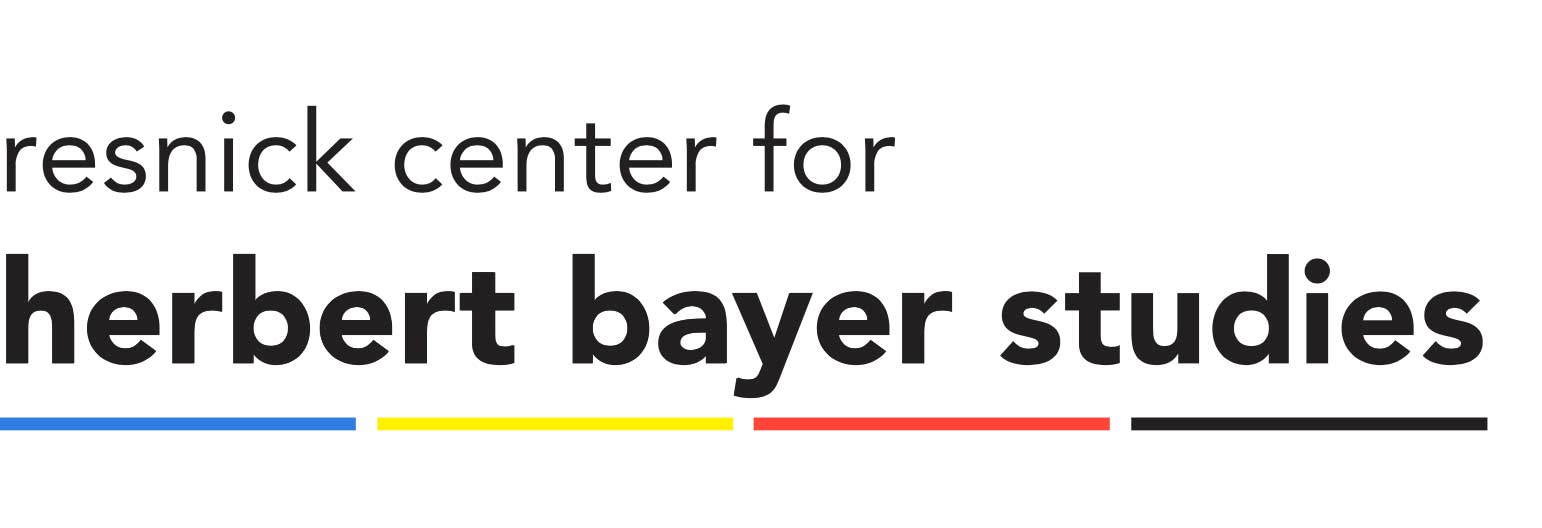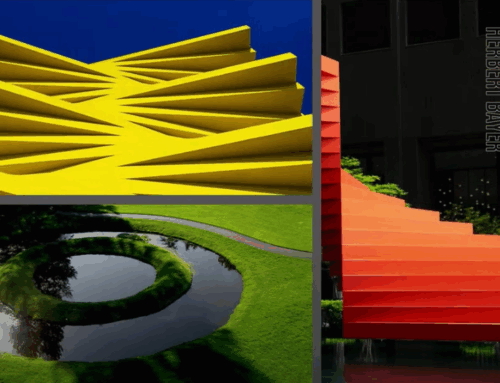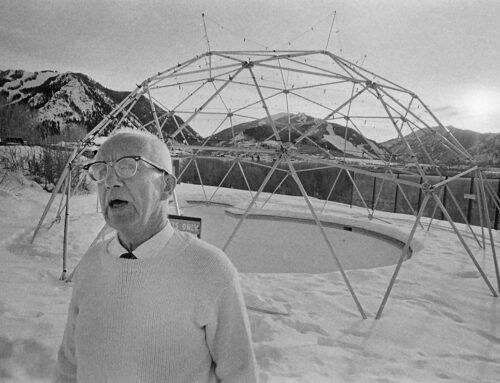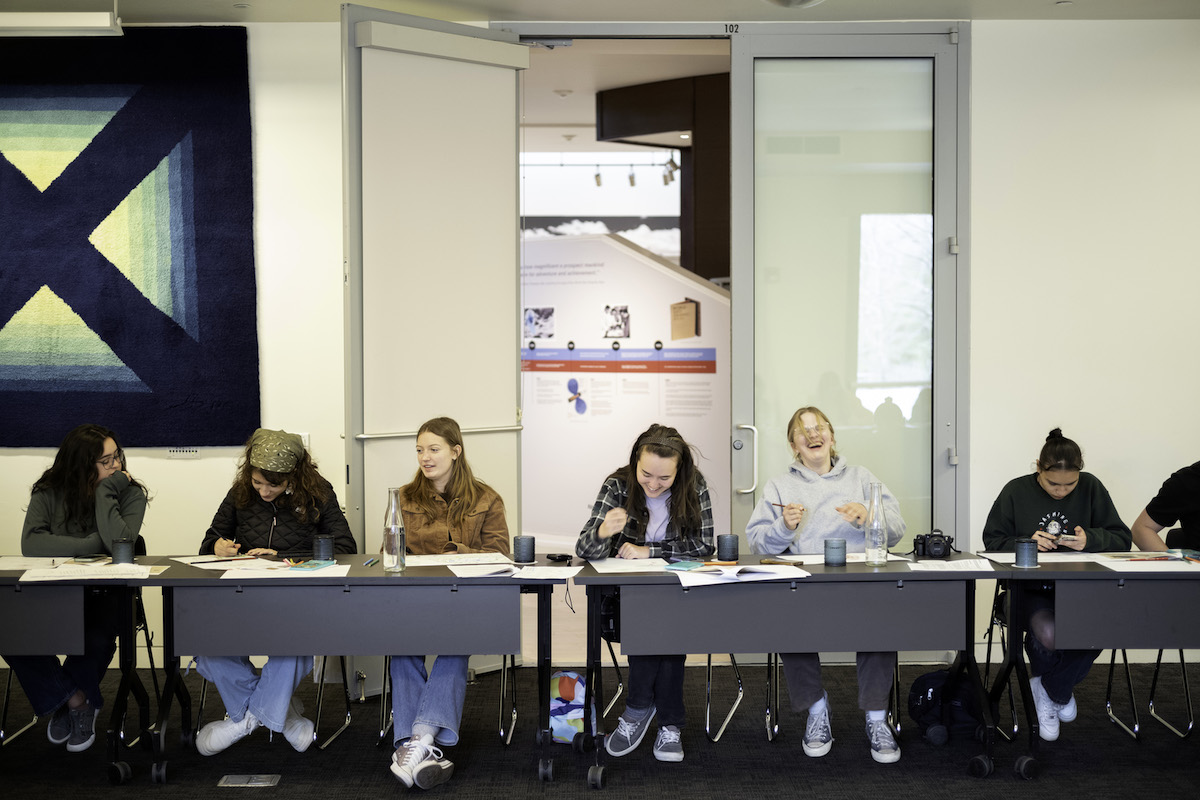
Credit: Daniel Bayer
The Bayer Center’s Freshman Year
Andrew Travers looks back on the first school year of Bayer Center educational programming.
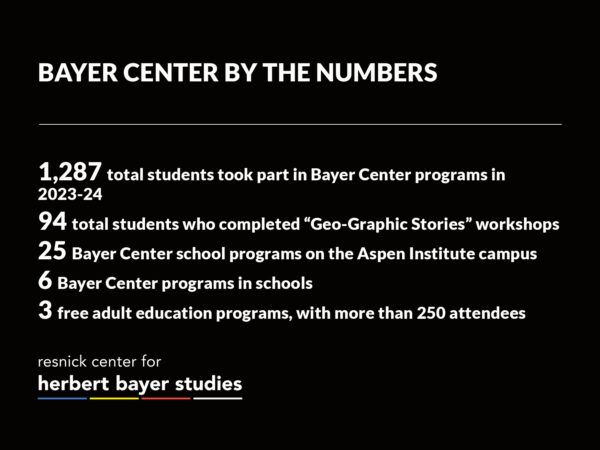
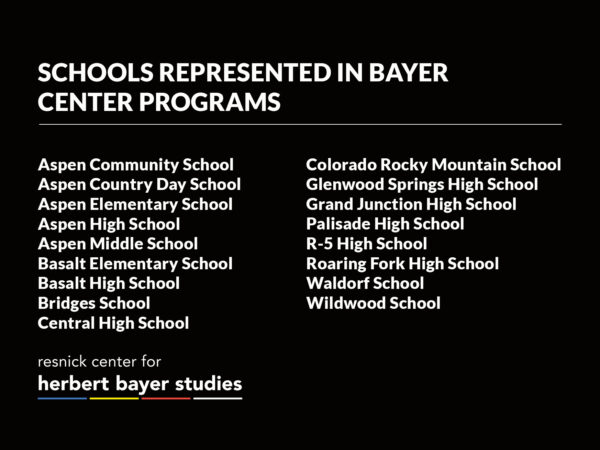
A parent stopped me recently when I was picking up my kid from after-school gymnastics at the Red Brick Center in Aspen. This parent had seen my name on a permission slip for her daughter to come on a field trip to the Bayer Center and asked, “What’s Bayer? What’s a Bayer Center?” An elementary school-aged boy nearby overheard and interjected, in rapid-fire fashion with a know-it-all swagger: “You’ve never heard of Herbert Bayer? He was this artist and he lived here and he made this cool atlas and this big globe you can go in and all these buildings and things and…”
I let him take over and allowed myself a moment of pride: that this young person had evidently taken part in one of the 30-plus school programs I organized for the Bayer Center during the 2023-24 school year; that, more importantly, he had retained some info to share; and, most importantly, he sounded genuinely excited about it. I believe there are many such young people whose creativity and curiosity have been ignited by the multidisciplinary work of Herbert Bayer in this inaugural school year for Bayer Center educational programs.
We directly connected with more than 1,200 young people from seventeen schools between Aspen and Grand Junction, Colorado, including 564 pre-K-through-high-school students in twenty-five programs we hosted on the Aspen Institute campus and 723 students in six in-school programs in Aspen and Basalt.
These have included frequent field trips to interact with our exhibitions and experience Bayer’s earthworks, sculpture and architecture on the Institute campus as well as several workshops with 94 total high school students, an all-school assembly on Herbert Bayer at Aspen Elementary School and partnering with the Aspen Art Museum to launch the “Basalt Art Days” series at Basalt Elementary School.
We’re now looking ahead to next school year and taking stock of our freshman year.
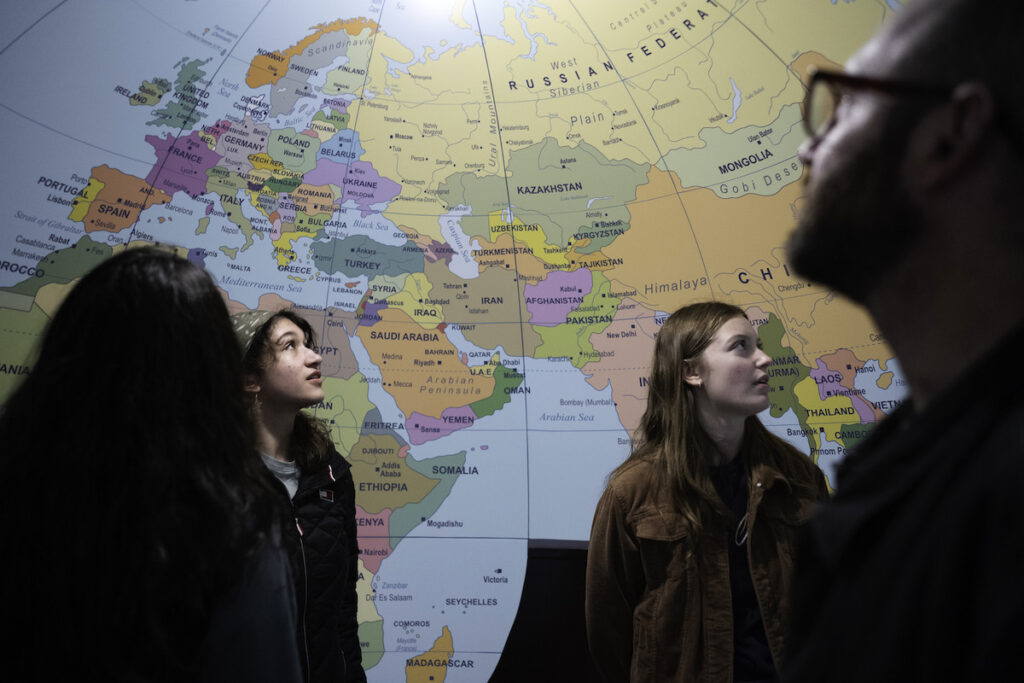
High school students inside the replica of Herbert Bayer’s “Outside-In Globe” in the Resnick Gallery exhibition “Charting Space: Herbert Bayer’s World Geo-Graphic Atlas at 70.” Credit: Daniel Bayer
LOOKING BACK AT A YEAR OF FIRSTS
A year ago, I was just starting outreach to begin launching an education program for the still-pretty-new museum. The challenge was to design programs for everyone from pre-K through 12th grade, as well as adults and the global Aspen Institute community that convenes in Aspen. I curated an exhibition, “Charting Space: Herbert Bayer’s World Geo-Graphic Atlas at 70,” that would serve as a launchpad for our educational programs, aiming to make it accessible and exciting to that broad swath of constituencies.
I also was driven to build community through these programs, establishing the Bayer Center as a welcoming place for all and drawing in regional audiences who might view the Institute as intimidating and cloistered and who might not yet know of Bayer. My hope is that the educators and parent/chaperones who’ve taken part in our school programs – 200 and counting – might serve as ambassadors and help us fling open the doors of welcome yet wider. “We will definitely spread the word about this program,” one parent wrote me after chaperoning. “It was interesting to even start seeing how many adults don’t even know what is in their own back yard.”
“Charting Space” presents Bayer’s radically ambitious work on the atlas in an interactive exhibition that serves as a teaching tool on outer space and cosmogony, local and world history, map projections and cartography, art and design, geography and sustainability. It also includes a replica of Bayer’s 1943 “Outside-In Globe,” which has proved to be a hit with visitors of all ages (and an effective vehicle to discuss art and design’s role in promoting international cooperation and creating possibilities for a better world).
Bayer, I’ve found, is a tremendous gift to educators. His work is so cross-disciplinary and touches so many areas of inquiry that I can design a program to meet just about any group’s interest and just about any school curriculum. For example, using Bayer and his work, I hosted sixth graders who were working on a thematic mapping unit, provided a capstone experience for International Baccalaureate high schoolers completing a two-year Environmental Systems & Societies course, and led a workshop for teens who convened on themes of “Courage, Healing and Repair.”
For our youngest visitors, I often start campus visits with them sitting inside Bayer’s earthwork “Grass Mound” and asking the question, “What does an artist do?” They often say an artist paints, draws, sculpts, creates. We can use Bayer’s surrounding campus masterwork to discuss and expand their ideas about what art and design can do and introduce them to the vital creative ideas Bayer pursued from his time at the Bauhaus School through his decades in Aspen.
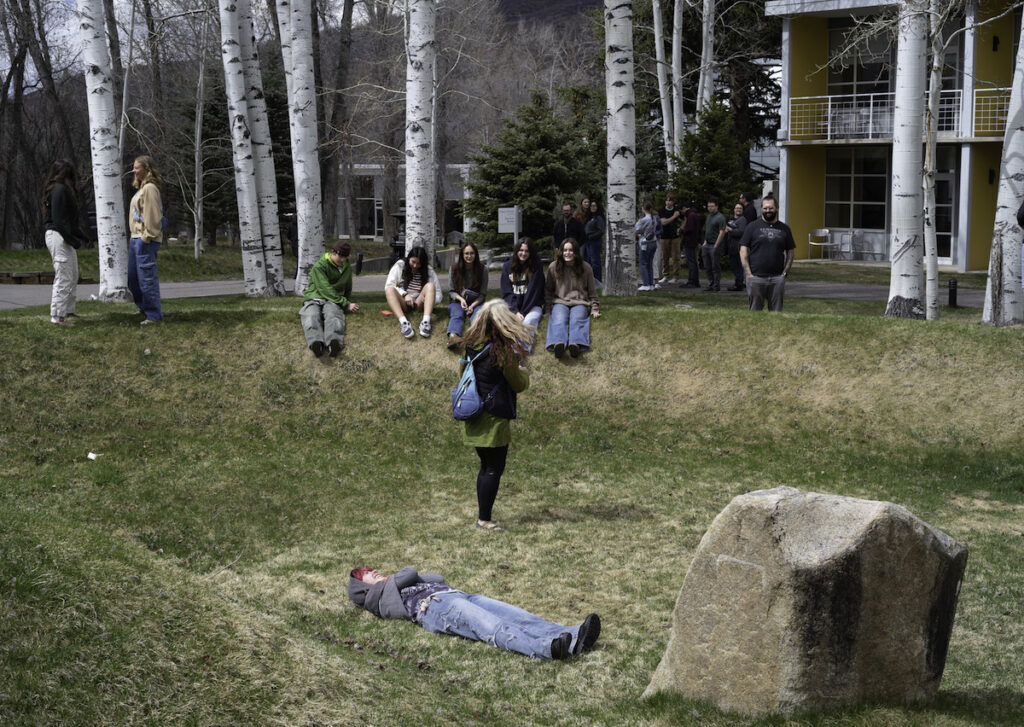
Students in and around Herbert Bayer’s “Grass Mound” on the Aspen Institute campus during a tour. Credit: Daniel Bayer
I began outreach last summer with art educators in the Aspen area, researching how the Bayer Center could be of maximum service to youth. I met regarding program development with a broad range of regional arts organizations and formed early partnerships with the Aspen Art Museum and Powers Art Center, who generously shared resources and expertise to help get me going. As a one-person education department, these partnerships have been essential. I also began connecting with administrators and teachers in the Roaring Fork Valley, and schools across Colorado’s Western Slope to form relationships and to learn what needs Bayer Center educational programs could fill.
The Aspen Institute’s Youth Action Forum functioned as a testing ground for an atlas-based workshop concept and allowed me to see how it connected with an international convening of elementary, middle, and high school students. The “Geo-Graphic Stories” workshop took students on tours of our exhibitions and then challenged them to apply Bayer’s graphic approach to tell their own stories of place, creating their own atlas pages of their own chosen place using illustrations and graphics that – like Bayer – touch on history, culture, geography, geology, economics and demography.
We hosted the workshop in various iterations throughout the school year, including a half-day workshop in February with 42 juniors and seniors from the alternative Bridges School in Carbondale and a half-day in April with 31 art students from five Grand Junction area high schools.
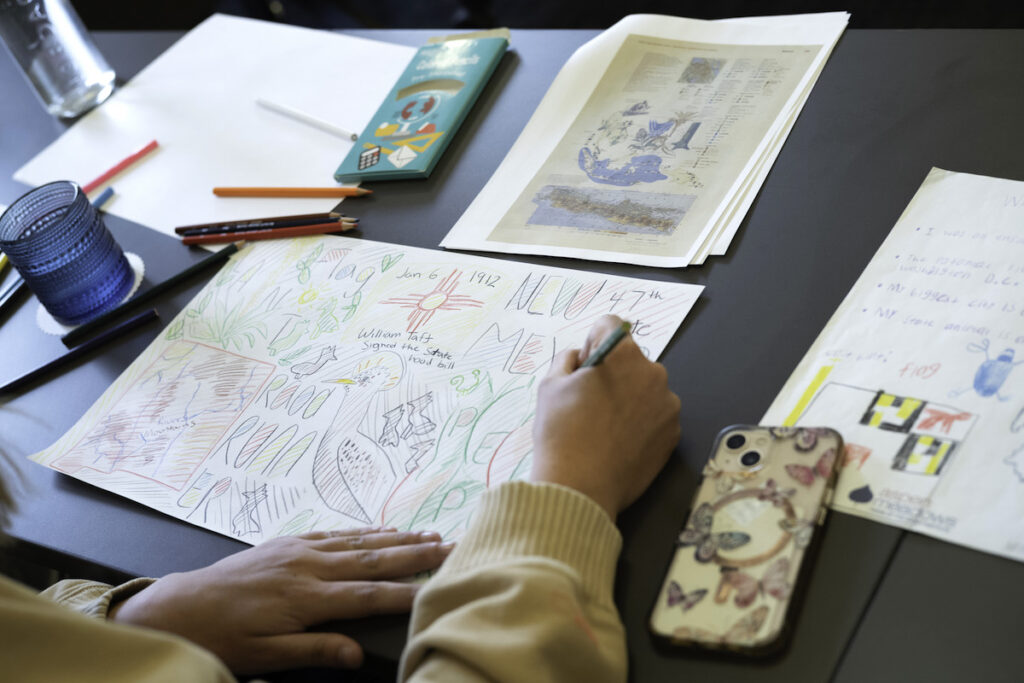
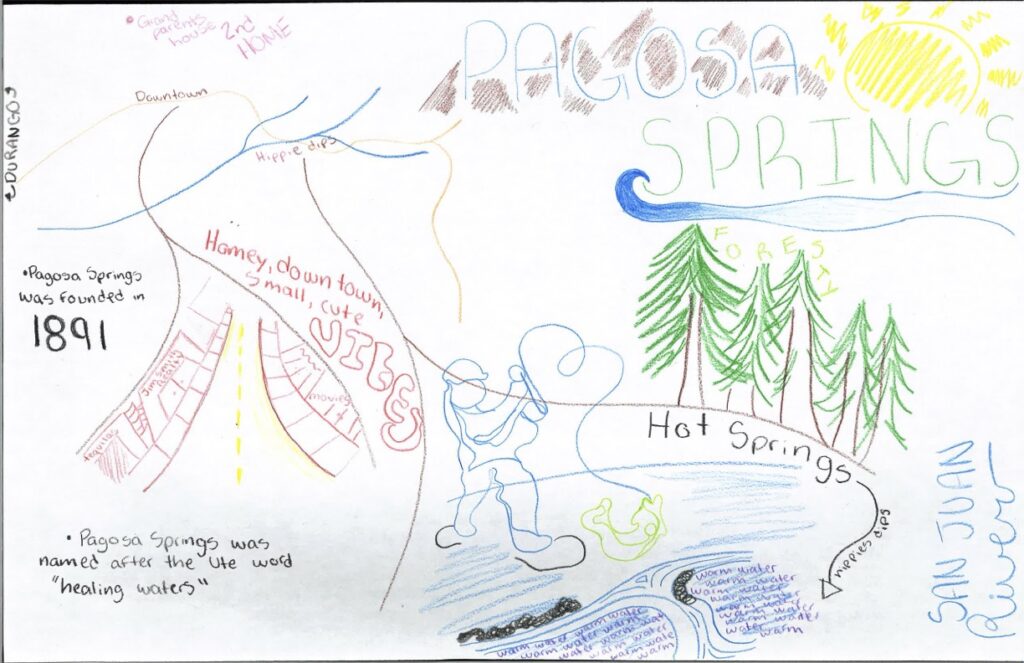
Left: A student at work in a Bayer Center “Geo-Graphic Stories” workshop. Credit: Daniel Bayer Right: An example of a student creation using Herbert Bayer’s visual strategies to create a graphic story of place.
As the school year opened, we began hosting field trips, accommodating a broad range from pre-K through high school, tailoring experiences to each group’s needs. For large groups, I often tag-teamed with the brilliant landscape architect and community leader Ann Mullins – splitting groups into two, with Ann leading half on campus tours and me the other half in the exhibition.
For our first Teacher Day in October, we hosted the 55-member teaching staff of Aspen High School for introductory tours to the Bayer Center led by my extraordinary colleagues Sarah Shaw and Rebecca Weiss, and a campus tour with Ann (thunderstorms were forecasted that day, but instead we got a rainbow…through the snowy cold winter I learned Colorado kids and educators are willing to talk Bayer and walk his campus in just about any weather).
In February, Aspen Elementary School invited me to lead an all-school assembly on Herbert Bayer. I’d done a lot of public speaking in my career and faced a variety of grown-up crowds and stuffy Institute audiences, but the prospect of addressing 464 elementary schoolers was more intimidating than any. I needn’t have worried. For our 30 minutes together, the students responded with extraordinary enthusiasm to Bayer’s artwork and Bauhaus ideas, which I presented in a slideshow – met with literal oohs and squeals for his photo collage “In Search of Times Past,” cheers for a video produced by Bayer’s granddaughter, Koko, and for the revered Aspen-based actor and Aspen Historical Society educator Mike Monroney, who performed a monologue as Bayer.
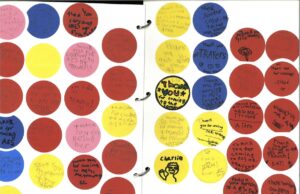
Following my all-school assembly, students from Aspen Elementary School sent me a thank-you in the form of a booklet inspired by Herbert Bayer’s 1970 screenprint “Birthday,” in which each student wrote a thank you in their own circle.
Along with the school programming launch this school year, we provided an eight-page Activity Kit for young visitors to the exhibition “Concept of a Visualist” at the Bayer Center. The handout engaged the Bayer Center’s youngest guests with an educational resource and creative outlet, including “image hunt” activities to help young people engage with exhibition artwork and space for sketching.
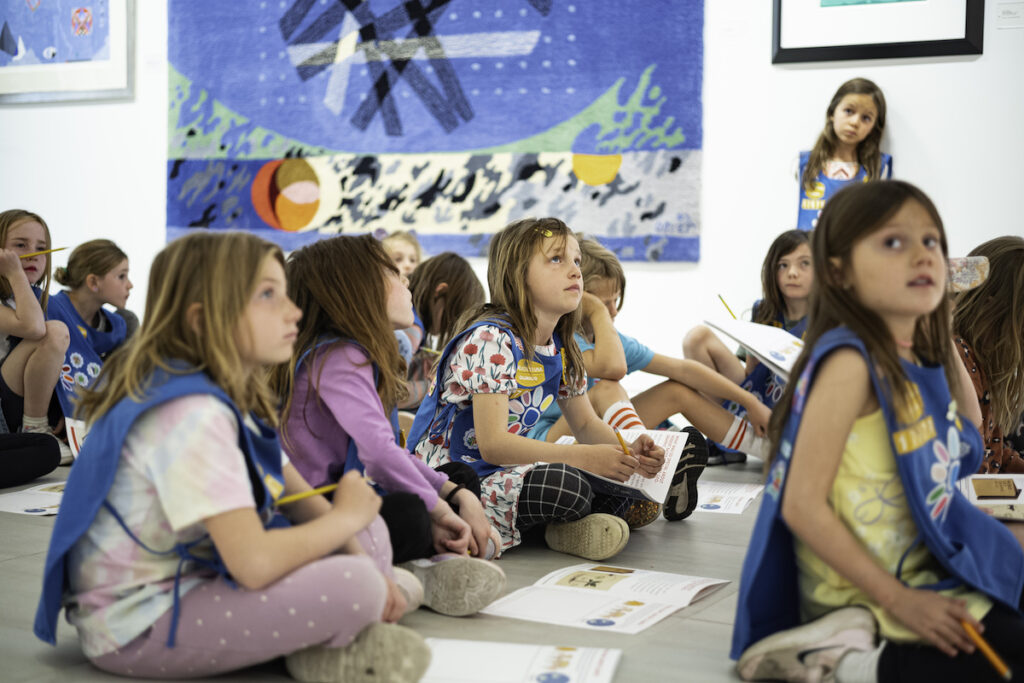
Girl Scouts of Aspen earned their Art & Design merit badge through a Bayer Center program on April 24, 2024. Credit: Daniel Bayer
In March, we teamed with the Basalt Education Foundation and the Aspen Art Museum for “Basalt Art Days,” a five-week series at Basalt Elementary School where artists and a wide variety of art organizations provided art-making experiences for a full grade of students on the school’s early release Wednesdays. Each organization brought their own experience, ranging from flag-making and paper-making to Native American dance (each week, I did a truncated version of my Bayer and Bauhaus presentation followed by Bauahus-inspired collage projects), and eager students moved from one station to the next throughout the day. The program met a specific need: Basalt has adopted a bilingual curriculum to serve English- and Spanish-speaking students, which has created a need for more preparation time for its teachers. Basalt Art Days, while giving students inspiring creative experiences, also provided teachers with that urgently needed prep time.
This was an eye-opening experience, realizing that our educational resources could be an effective tool to address equity and teacher retention issues, and could in the future achieve more such outcomes and meet community needs while simultaneously sparking curiosity and introducing young people to Herbert Bayer’s art and design.

At Basalt Art Days in March 2024, elementary school students created “Bauhaus Bird” collages after learning about Herbert Bayer and Bauhaus principals. Credit: Julia Hrabovsky
LOOKING AHEAD
For the school year to come, we’ll be reaching as many young people as we can through experiences on campus and in our exhibitions, as well as in schools. We’ll be launching a new workshop series based on “Bauhaus Typography at 100,” we will have a new Activity Kit on hand and I am looking forward to continuing to learn from the inquisitive and inspiring people I meet doing this work.
If you are a teacher, administrator, artist, parent, student, or anyone else interested in the Bayer Center’s educational resources, I’d be thrilled to hear from you and work with you. Pre-visit materials and curricular options are available on request. There is no fee for Bayer Center school programs and we have funds available to cover field trip-associated costs. Email me at andrew.travers@aspeninstitute.org or call me at (970) 544-7333.
Andrew Travers is the inaugural Penner Manager of Educational Programs at the Resnick Center for Herbert Bayer Studies. Based in Aspen, he is responsible for designing, implementing, and evaluating the Center’s educational programming and public engagement initiatives.
Funding for Bayer Center education programs and related activities is provided by the Laurie M. Tisch Illumination Fund.
June 1, 2024
ADULT EDUCATION INITIATIVES
For Bayer Center adult education programs, we’ve aimed to build understanding of Bayer’s art and design with accessible, free events that attract a wide range of community members. They have included:
- A September 2023 outdoor talk with art conservator Mike Carpenter, who oversaw a restoration of Bayer’s “kaleidoscreen” sculpture on campus, discussing the work’s history and the importance of conservation projects at the Aspen Institute and beyond. Twenty-seven people came to “kaleidoscreen” to hear my conversation with Carpenter. WATCH IT HERE
- A December talk at Paepcke Auditorium with artist and Bayer assistant Richard Carter, presented in partnership with the Institute’s Aspen Community Programs and moderated by Society of Fellows senior director Genna Moe. An audience of 208 came to Paepcke Auditorium for the discussion. WATCH OUR CONVERSATION HERE
- A March talk at the Pitkin County Library with recycling symbol creator Gary Anderson, whose symbol was unveiled at the 1972 International Design Conference in Aspen as the winner of a contest judged by Bayer and other leading designers, with Recycle Colorado executive director Liz Chapman. It drew 57 people to the Library’s Dunaway Room. WATCH HERE
- Talks and tours with Aspen Institute groups including Aspen Ideas: Health and Aspen Ideas Festival, the Bezos Scholarship Program, the Aspen ESG Summit and Aspen Executive Seminars.
more
